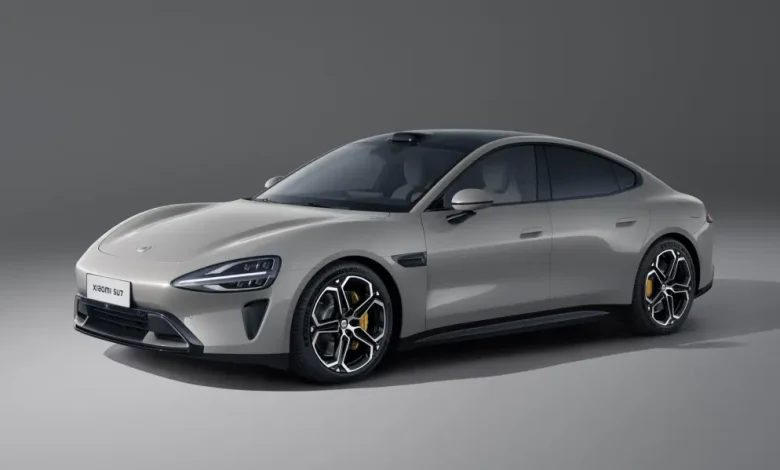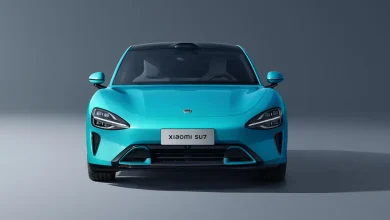Xiaomi Unveils its Debut Electric Sedan, the Xiaomi SU7: A Game-Changer in the EV Market

Xiaomi, renowned for its cutting-edge smartphones, has officially entered the electric vehicle (EV) arena with the launch of the Xiaomi SU7 electric sedan. This move comes nearly three years after Xiaomi’s CEO and founder, Lei Jun, announced plans to invest a substantial 10 billion yuan (1.4 billion USD) into the company’s car manufacturing business.
The Xiaomi SU7 boasts an impressive set of features, including an 875 V charging system and a robust 101 kWh battery packed with CATL cells, delivering an outstanding maximum range of 800 km. The all-wheel-drive (AWD) version of the Xiaomi SU7 flexes its muscles with 495 kW of power, propelling it from 0 to 100 km/h in a mere 2.78 seconds, and reaching a top speed of 265 km/h.
Xiaomi’s commitment to the EV market materialized at a landmark event held 1003 days after the initial announcement. The company had previously teased the SU7 through spy shots and testing videos that surfaced online in late 2023. MIIT’s revelation that Xiaomi applied for a sales license in China gave enthusiasts a sneak peek into the key specifications of the SU7.
Xiaomi SU7 Versions
The Xiaomi SU7 lineup comprises two versions: the base model SU7, a rear-wheel-drive (RWD) powerhouse featuring Xiaomi’s in-house developed V6 engine with 220 kW of power, and the performance-oriented SU7 Max, an AWD variant boasting dual motors with a staggering 495 kW output. The latter achieves a 0-100 km/h acceleration in 2.78 seconds and an impressive 800 km range under the CLTC standard.

The SU7’s charging capabilities are equally impressive, outpacing the Tesla Model S Plaid. In just 10 minutes, the battery can recharge 390 km, with 220 km added in 5 minutes and a remarkable 510 km in 15 minutes.
Xiaomi emphasizes the SU7’s aerodynamic prowess, sporting a drag coefficient of only 0.195 Cd, the lowest among production vehicles. Lei Jun highlighted the sleek design of the lidar, inspired by the smooth contours of a pebble. Interestingly, the model showcasing the 0.195 Cd in the promotional video is without lidar.
Built on Xiaomi’s Modena platform, the Xiaomi SU7 measures 4997/1963/1455 mm (L/W/H), slightly longer than the Porsche Taycan, with a wheelbase of 3000 mm. The interior, masterfully designed by Xiaomi’s Head of Design, Li Tianyuan, offers a spacious 105-liter frunk and 517 liters of boot space.
Inside, users are greeted with a 16.1″ central control screen boasting 3k resolution, a 7.1″ instrument panel for the driver, and rear screens for passengers using Xiaomi tablets known as Mi Pads. Connectivity and integration are taken to the next level with the HyperOS, powered by Qualcomm Snapdragon 8295, promising seamless integration with Xiaomi’s vast ecosystem, including cars.
The autonomous driving system, Xiaomi Pilot, powered by two Nvidia Orin-X chips, features one lidar, 3 millimeter-wave radars, 11 HD cameras, and 12 ultrasonic radars. The system encompasses highway driving, self-parking, and car summoning, with city driving expected to be available in over 100 cities in China by the end of 2024.
CEO Lei Jun aims high, expressing Xiaomi’s ambition to be among the top 5 car companies globally in the next 15-20 years. While pricing details are yet to be disclosed, Carnewschina speculates that the base model may start under 300,000 yuan (42,500 USD). With mass production slated to begin in H1 2024, the Xiaomi SU7 has sparked significant interest and anticipation in the EV market.
You may also interested in: “Xiaomi Unveils Groundbreaking Electric Vehicle Technologies at Xiaomi EV Technology Launch“




